
Summary of Argument
The spike in violent crime by juveniles in the late 1980s and early 1990s triggered widespread fears about the causes and extent of juvenile violence. Many states changed their laws regarding the transfer of juveniles to the adult criminal system in response to this increase in juvenile crime, subjecting juvenile offenders to sentencing regimes that were originally conceived for adults, including sentences of life without parole.
The fears of a juvenile crime wave that prompted these changes became embodied in the notion of a “juvenile superpredator,” which was reflected in academic and political discourse. Juvenile superpredators were characterized as ruthless sociopaths who lacked a moral conscience and were unconcerned about the consequences of their actions and undeterred by punishment.
However, the fear of an impending generation of superpredators proved to be unfounded. Empirical research that has analyzed the increase in violent crime during the early- to mid-1990s and its subsequent decline demonstrates that the juvenile superpredator was a myth and the predictions of future youth violence were baseless. Amici have been unable to identify any scholarly research published in the last decade that provides support for the notion of the juvenile superpredator, and the scholar credited with originating that term has acknowledged that his characterizations and predictions were wrong; he is one of the amici who submit this brief.
In addition, prison sentences of life without parole, whether discretionary or mandatory, have not been shown to have a deterrent effect on juvenile crime, and the incarceration rates of juveniles pursuant to such sentencing policies demonstrate no causal relationship to the significant reduction in juvenile violent crime since the mid-1990s. There is no empirical basis for any concern that declaring unconstitutional sentences of life without parole for juvenile offenders would result in an increase in violent juvenile crime.